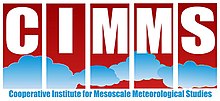Cooperative Institute for Severe and High-Impact Weather Research and Operations
This article needs additional citations for verification. (April 2014) |
| Abbreviation | CIWRO |
|---|---|
| Established | 1978 |
| Coordinates | 35°10′53″N 97°26′24″W / 35.1814°N 97.44°W |
| Employees | 215 (2023) |
| Website | ciwro |
The Cooperative Institute for Severe and High-Impact Weather Research and Operations (CIWRO) is one of 16 NOAA Cooperative Institutes (CIs), hosted at the University of Oklahoma.[1] Before Oct. 1, 2021, it was known as the Cooperative Institute for Mesoscale Meteorological Studies (CIMMS).[2] The CIMMS/CIWRO, a research organization created in 1978 by a cooperative agreement between the University of Oklahoma (OU) and the National Oceanic and Atmospheric Administration (NOAA), promotes collaborative research between NOAA and OU scientists on problems of mutual interest to improve basic understanding of mesoscale meteorological phenomena, weather radar, and regional climate to help produce better forecasts and warnings that save lives and property. CIMMS/CIWRO research contributes to the NOAA mission through improvement of the observation, analysis, understanding, and prediction of weather elements and systems and climate anomalies ranging in size from cloud nuclei to multi-state areas.
Mission
[edit]CIMMS/CIWRO concentrates its research and outreach efforts and resources on the following principal themes:.[3]
- Weather radar research and development
- Stormscale and mesoscale modeling research and development
- Forecast improvements research and development
- Impacts of climate change related to extreme weather events
- Social and socioeconomic impacts of high impact weather systems
National Weather Center
[edit]
CIMMS/CIWRO is part of the National Weather Center, a unique[citation needed] confederation of federal, state, and OU organizations that work together in partnership to improve understanding of the Earth's atmosphere. Recognized[citation needed] for its collective expertise in severe weather, many of the research and development activities of the Center have served society by improving weather observing and forecasting, and thus have contributed to reductions in loss of life and property. Many entities of the National Weather Center played a key role in the decade-long, $2 billion modernization and restructuring of the National Weather Service. National Weather Center organizations employ 650 individuals and provide more than $45 million annually to the Oklahoma economy. Today, all organizations are collocated in the new National Weather Center facility, which was completed in 2006 at a cost of $69 million.[citation needed]
Collaboration
[edit]CIMMS/CIWRO promotes cooperation and collaboration on problems of mutual interest among OU research scientists and students and the NOAA Office of Oceanic and Atmospheric Research (OAR) National Severe Storms Laboratory, NOAA Air Resources Laboratory, National Weather Service Radar Operations Center for the WSR-88D (NEXRAD) Program, NWS National Centers for Environmental Prediction Storm Prediction Center, NWS Warning Decision Training Division, the NWS Forecast Office in Norman, Oklahoma, and the NWS Training Center located in Kansas City, Missouri.[citation needed]
References
[edit]- ^ "Cooperative Institutes". NOAA Office of Oceanic and Atmospheric Research. Archived from the original on 2023-12-08. Retrieved 2023-12-12.
- ^ "NOAA names University of Oklahoma to host new institute for severe and high-impact weather research - Welcome to NOAA Research". research.noaa.gov. Retrieved 2021-10-01.
- ^ Cooperative Institute for Severe and High-Impact Weather Research and Operations (2023). "Present Research". ciwro.ou.edu. Retrieved 2023-12-13.
